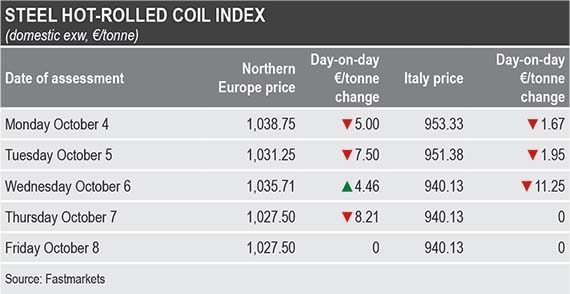Market activity was still subdued but was expected to recover in late October-November when distributors start to restock material for the first quarter of next year.
Fastmarkets calculated its daily steel hot-rolled coil index, domestic, exw Northern Europe, at €1,027.50 ($1,188.83) per tonne on October 8, down by €16.25 per tonne week on week and by €83.33 per tonne month on month.
Given the lack of market activity on Friday, the index was based on four estimates heard on Thursday at €1,025-1,030 per tonne ex-works.
Fastmarkets calculated its corresponding daily steel HRC index, domestic, exw Italy, at €940.13 per tonne on October 8, down by €14.87 per tonne week on week and by €72.37 per tonne month on month.
The Italian market was quiet on Thursday and Friday, although a deal for 1,000 tonnes was heard on Wednesday at €940 per tonne ex-works.
In the meantime, sentiment regarding the price trend among buyers remained mixed.
Some blamed this on the lower demand from the automotive sector, higher production rates of domestic HRC and competitive offers from some Central European mills.
Car manufacturers have been running at reduced rates recently because of the global semiconductor shortage, resulting in extra volumes of HRC being released to the spot market. Sources said the auto industry had booked 20-30% less steel than expected so far in 2021.
A producer from Hungary offered HRC to Germany at €900 per tonne ex-works and was reported to be ready to give discounts. Two sources said that a Central European mill made a deal at €840 per tonne ex-works, but the information was not widely confirmed.
German steelmaker Thyssenkrupp restarted its “Schwelgern 1” blast furnace on October 1, it announced last week. The maximum capacity of the furnace is 3.6 million tonnes per year of pig iron.
Some sources claimed that HRC demand from other end-consumers, including the construction and white goods sectors, remained strong and that distributors would resume trading soon. In addition, the cheapest import material was subject to EU safeguard duties.
Indian producers exhausted their quarterly quota for imports of HRC into the EU in the first few days of the new safeguard period. Due to there being high stocks of overseas steel, Italian importers of flat steel have had trouble bringing in new material because ports are so full with Indian coil that no space is left for other products.

